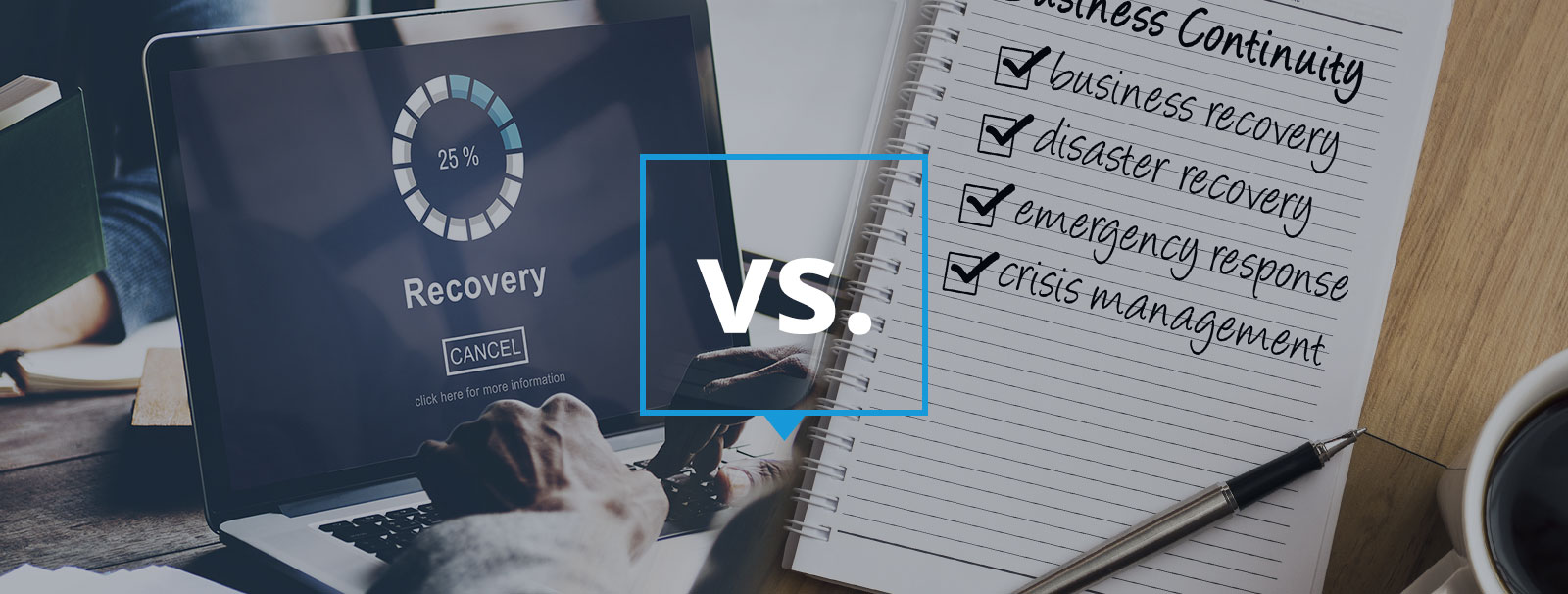What’s the difference between disaster recovery and business continuity?
Your business faces challenges at every turn, from cybersecurity threats to natural disasters. The worst thing you can do is not have a plan for what to do when disaster strikes. And the best thing you can do is be prepared with both a disaster recovery plan and a business continuity plan.
Some people use the terms “disaster recovery” and “business continuity” interchangeably. The concepts are connected, so the misuse of these two terms is understandable. However, they’re not the same thing, and it can be risky to discuss them as if they are.
It’s important to understand the difference, that’s why we compiled this guide.
In this guide we’ll cover:
What is disaster recovery?
Disaster recovery focuses primarily on preserving and managing data in the face of potential disasters such as human error, cyberattacks, hurricanes, floods, and power outages. It recognizes that even small bouts of downtime can add up to have a significant effect such as eroding customers’ trust in a company.
Key components of disaster recovery include continuous monitoring of essential systems and continuous data and system backups. A disaster recovery plan dives into acceptable levels of data loss, recovery times and prioritizing critical IT processes.
Smaller businesses may be able to tolerate more downtime, while just an hour’s downtime can be extremely expensive for a large company.
Some important elements of a good disaster recovery plan include:
- BYOD policies
- Employee training on issues such as strong passwords, cybersecurity risks, and phishing scams
- Network security
- Data breach protection policies
- System maintenance
- Regular network assessments
- Operational needs
- Recovery time estimates
- Appropriate data storage options (cloud, local, hybrid)
- Budgets for data backup and recovery
As you can see from the list above, not all parts of your plan should focus just on recovery. Preventative measures, like employee training, could keep potential disasters from ever occurring. For instance, an employee who might otherwise have fallen for a phishing email never does, and cybersecurity tools such as firewalls fend off a hacking attempt that would’ve, in other circumstances, led to hacking that crippled a business.
What is business continuity?
Business continuity focuses on keeping a business operational during a disaster, and one part of that is data preservation (disaster recovery). In other words, disaster recovery is part of business continuity.
“A business continuity plan, or BCP, is a lifeline and a road map to help steer your business through any crisis. A good BCP is vital to get up and running fast after a major interruption of operations.”
– Forbes
Business continuity is not something to be taken lightly. Did you know that 40-60% of small businesses never reopen after a disaster? And 48% of small businesses report operating without any type of business continuity plan. It’s not hard to do that math and see that having a plan in place before disaster strikes could be the thing that keeps your business from becoming a statistic.
In addition to keeping your business up and running, having a business continuity plan offers many other benefits. A good continuity plan can save lives because part of the plan should involve training your employees on what to do in the face of a disaster. A good plan can also help build confidence with your customers and give your business a competitive edge.
A business continuity plan consists of goals, identification of key personnel and their responsibilities, business impact analysis results, employee safety, crisis communications and continuous IT operations (disaster recovery).
Important elements of business continuity include:
- Identifying critical business processes, assets, partners and employees, and how they interconnect with the various business functions
- How much interruption is acceptable for each function
- How to maintain operations (or get them going ASAP) when disruption occurs
Which is more important?
While both disaster recovery and business continuity are important, the key difference between them is their scope. As explained above, disaster recovery has a narrower, IT-centric focus compared with business continuity.
The focus of disaster recovery is on your IT operations. The focus of business continuity is on your entire business. This means your business continuity plan is the one that’s going to keep your doors open and your business operating.
That doesn’t mean that either plan should be developed in isolation. After all, much of what occurs in disaster recovery depends on the decisions made for business continuity and vice versa. For instance, telecommuting can be a viable option for many companies during a disaster, and both plans need to be consistent with each other on this front.
Communication is an essential element of both plans. The COO of one company even said, “I didn’t realize how many areas of communication had to be included in the DR plan.” Main issues include how IT notifies users when systems are up again and how IT staffers can communicate with frustrated users. It also needs to detail who in the company should handle external communications (it’s usually the folks in marketing or PR who do this best).
In addition, both plans need to be frequently evaluated and tested to ensure they’re ready to go should your business face a disaster. In fact, part of your plan should include a plan for keeping your plan updated. (Now say that ten times fast.)
In conclusion
If it seems confusing, consider working with an expert in cybersecurity and business continuity. A good IT support provider can help you create both business continuity and disaster recovery plans that work, as well as make sure your plans stay up-to-date. The right partner will also be your greatest asset if the time comes to put your plan into action.
Don’t leave the security of your business up to chance. Contact your managed IT services provider to make sure you have the right plan in place to protect your business.





